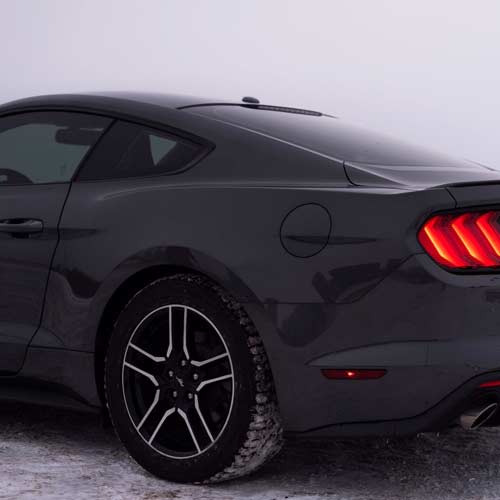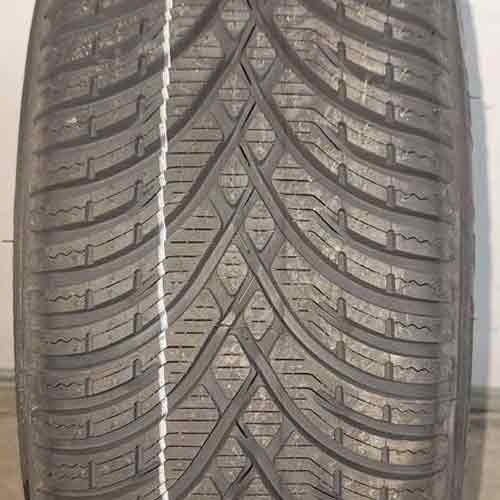The Kleber Krisalp HP3 is a pretty decent budget pick, which offers superb performance, especially in terms of road noise reduction, and snow traction. Let’s see if this tire’s for you.

Table of Contents
Key Takeaway
The Kleber Krisalp HP3 excels in:
- Snow Traction: Featuring laterally-arranged continuous running lugs and interlocking sipes, the tire ensures optimal snow contact and superb snow scooping abilities.
- Noise Comfort: Thanks to a well-engineered tread design and a special rubber compound, the tire offers reduced noise, enhancing ride comfort.
- Wet Performance: Showcasing a clear directional pattern with V-shaped grooves, it provides impressive resistance to aqua or hydroplaning and effective water evacuation.
Though the tire needs improvement in terms of the following:
- Ice Traction: Despite its thermally adaptive rubber, the tire lacks efficient biters and multi-directional siping, resulting in limited ice grip.
- Dry Performance: The tire’s design affects its linear grip and steering feedback, leading to suboptimal handling and braking in dry conditions.
- Tread Longevity: With a softer compound that is more prone to wear, the tire’s lifespan is comparatively short, delivering fewer miles on average than some competitors.
Info on Sizes: The Kleber Krisalp HP3 comes in 99 total sizes, in 14 to 20 inches rims, with T and H speed ratings, and all sizes having 10/32″ tread depth. Moreover, they all have SL/XL load ratings, and range 16 lbs to 32 lbs, in terms of weight.
Also Note: Since the tire offers best float speeds (resistance to hydroplaning), I added it to my list of top winter tires (stud-less), check it here:
https://snowytires.com/best-studless-winter-tires/
Tire Construction
The Kleber Krisalp HP3 comes with a very streamlined directional tread pattern.

Each lug acts as a single unit here, that goes from one end to another.
So you can say it’s a dual rib design, where there are just shoulder lugs meeting together in the middle.
Towards the middle area of the tread, one can clearly see how all lugs are placed on a secondary rubber layer.
Moreover, here sipes are linear and laterally oriented.
Though towards shoulders, they change into wave-like interlocking patterns.
Moreover, these shoulder lugs are also characterized by thick in-groove notches.
And yes, there are longitudinally oriented notches on these outer lugs’ area as well.
Tread Longevity
When it comes to tread longevity, a lot of factors have to be considered, including tire’s weight, tread compound and tread design.
And looking at all of them, one can see why the Kleber Krisalp HP3 is pretty lacking here.
Though the tire keeps its weight in check, and comes generating just an average rolling resistance, relatively, its softer compound is very prone to wear.
So at best, the tire is only able to give you 30k miles overall, on average.
Moreover, I’d like to add that, as the tire wears down more easily, it isn’t able to provide you with as much overall value. I mean there are better budget picks out there, and out of them, the one providing the most value is Barum Polaris 5 (review).
Overall Winter Performance
Tire efficiency during winter is largely determined by its aptitude on two primary terrains: ice and snow. And in both the tire’s design and material compositions are critical factors to consider.
Let’s check both of them out.
Snow Traction
For snow-covered roads, a tire’s efficacy lies in its ability to form snow-to-snow contact, while excess snow is scooped out of the way.
That’s why with (laterally-arranged) continuous running lugs, the Kleber Krisalp HP3 offers one of the best acceleration performance (in its budget friendly category of winter tires).
They offer superb snow scooping abilities, throwing back snow particles, generating forward momentum.
Moreover, the tire offers interlocking sipes on its shoulders, engineered to provide you with proper snow contact (which is a big deal, as snow doesn’t stick so well with rubber).
This offers you with pretty decent overall snow handling, relatively speaking.
Ice Traction
Tires designed for icy conditions incorporate specialized rubber compounds and biters (on their treads).
Since ice relatively has the lowest friction of all (terrain types), the overall tire’s grip relies predominantly on these elements to maintain vehicular stability and control.
Having said that, although the Kleber Krisalp HP3 offers a great thermally adaptive rubber, which keeps its biters pretty soft and flexible, its still isn’t able to provide you with good enough ice traction (relatively, comparing other winter tires).
That’s because the tire doesn’t offer efficient enough biters, to begin with. It’s tread lacks the multi-directional/angled biters highly needed here, and only comes with linear siping, (mostly towards the middle).
And although the tire does offer interlocking sipes on shoulders, they again with single angle/orientation aren’t effective to provide decent ice bite.
And besides, they are mainly designed for snow grip, instead, as already discussed.
So overall, the Krisalp is pretty lacking, when it comes to ice performance.
Overall Wet Performance
Wet performance is largely determined by a tire’s tread design and rubber composition, both of which are crucial for displacing water and maintaining grip on wet roads.
Now the Kleber Krisalp HP3 showcases advanced tread features good enough for these conditions.
First off, it forms a clear directional pattern with it’s V shaped grooves, and interconnects them laterally in a way, so that water from the middle could effectively evacuate out towards the shoulders and out of the tread.
So you get one of the best float speeds and overall resistance to aqua or hydroplaning.
While the design efficiently evacuates most of the water, the sipes play a role in managing residual moisture. These sipes act like mini vacuum cleaners, drawing in water particles.
However, their uniform (laterally arranged only) angles limit their effectiveness in providing comprehensive wet traction and multi-directional grip.
Although the tire comes with a soft rubber composition, its linear siping design tends to restrict flexibility during cornering (for the most part), resulting in reduced response times and lateral grip.
Nonetheless, it performs reasonably well in straight-line wet grip, as indicated by its braking distances.
Side Note: Out of all winter tires in the category, the Michelin Pilot Alpin PA4 (review) is pretty great. Though its also been replaced with PA5.
Dry Performance
While wet and winter performances are crucial, dry traction remains an integral aspect of tire efficiency too. This traction is influenced by the extent of rubber contact with the road and encompasses both grip and tire’s steering response/handling.
Let’s check all these dimensions.
Dry Linear Grip
Linear grip is the tire’s traction when it moves in a straight line. And it relies on the central tread’s contact with the road. Moreover, as this grip is directional it’s measured by tire’s braking efficiency.
Having said that, it makes sense why the Kleber Krisalp HP3 here is pretty lacking here, I mean relatively, comparing others in its category.
But why is that happening, even though the tire features lighter structure with reinforced foundations (adding to its on-center feel).
Well, this has to do with the tire’s relatively more voided up design, with laterally arranged lugs. It’s simple really, as with laterally arranged voids, the tire isn’t able to make proper contact with the road, as it rolls straight, leading to limited overall grip.
Lateral Grip And Steering
Dry handling combines lateral traction and steering feedback. The tire’s shoulder lugs determine its lateral grip since they interact more with the road during turns, while steering comes by a lot of variables.
Now, in terms of grip, the Kleber Krisalp HP3 is actually pretty great, offering decent values, as seen by its lateral g forces generated (on average).
However, overall the tire still comes below average when it comes to overall handling.
But why? Well, this has to do with it’s lacking steering feedback.
Actually, the tire comes with a pretty relative softer tread, causing lugs to flex more as the tire corners. This leads to lagging and vague steering, especially when it comes to mid-cornering feedback.
Moreover, with slower braking, the tire also takes more time slowing down before entering the corners, hurting its overall handling scores.
Fuel Economy
Fuel efficiency in tires is influenced by their weight and traction characteristics.
But why? Well, heavier tires with significant tread gaps experience more lug flexing during motion. This flexing consumes energy that could otherwise be used for rolling, leading to increased energy demands and reduced fuel efficiency.
Now, the Kleber Krisalp HP3 doesn’t carries a lot of weight, and has all its lugs backed up by foundational supports. Moreover, there aren’t a lot of in-groove notches and multi-angled biters, as mostly seen on other winter tires.
So although the tire generates less overall grip (on dry), it pays you back (literally), with its economical fuel consumption instead.
So the Krisalp is a pretty average tire, in terms of its fuel consumption.
Noise Comfort
Tread design influences the acoustics of a tire a lot, where the size of tread voids are directly correlated with the amount of noise generated.
But that’s not really the case when it comes to Kleber Krisalp HP3, as the tire offers a pretty well engineered design, where air particles although enter through the voids of shoulders, don’t get to hit around the tread walls (which generates noise to begin with).
Instead those grooves are streamlined in a way, that most of the air just pass by without impacting.
Moreover, the tire also features special rubber compound, which diminishes in-groove resonance as well.
To Conclude
The Kleber Krisalp HP3’s performance across various terrains and conditions reveals a mixed bag.
In terms of winter performance, although the tire shines on snowy terrains, lacks with its below-average performance on ice, mainly because of its lack of biters.
These lacking biters also can’t provide this tire with ample wet traction as well. Though the tire’s effective directional pattern do offer superb resistance to aquaplaning, that’s for sure.
Moreover, its dry performance is also not impressive, where although its lateral grip is decent, the tire falters in terms of linear grip and steering feedback, leading to subpar handling.
Moreover, its softer compound also lacks in terms of tread longevity, decreasing its overall value.
Though on the positive note, the tire offers above average fuel economy and one of the quietest ride, when it comes to budget-friendly winter tire category.